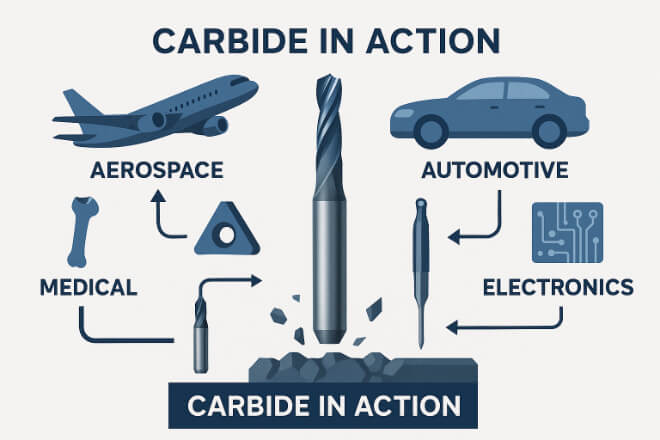절삭 공구에 있어서 텅스텐 카바이드는 강도, 속도, 신뢰성이 필요한 전문가에게 필수적인 소재입니다.
하지만 모든 초경 공구가 동일하게 제작되는 것은 아닙니다. 선택하는 텅스텐 카바이드 등급은 공구의 성능과 수명에 큰 영향을 미칠 수 있습니다.
알루미늄, 강철 또는 복합소재를 절단할 때, 최상의 결과를 얻으려면 올바른 카바이드 등급을 사용하는 것이 중요합니다.
이 가이드는 카바이드 등급이 무엇을 의미하는지, 왜 중요한지, 그리고 작업에 가장 적합한 등급을 선택하는 방법을 이해하는 데 도움이 됩니다.
1. 텅스텐 카바이드 등급은 무엇입니까?
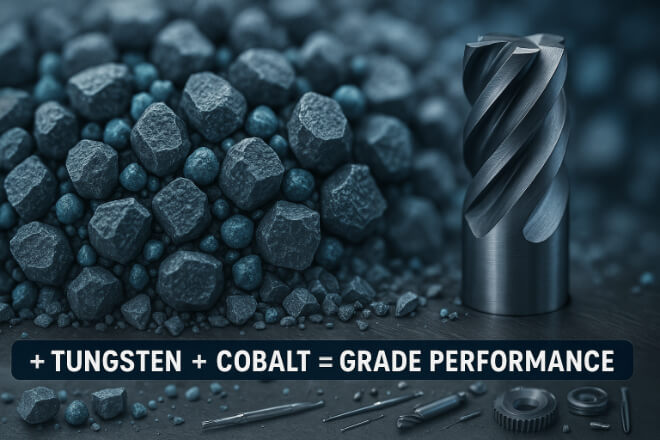
텅스텐 카바이드 등급은 텅스텐 카바이드와 도구에 영향을 미치는 기타 재료(예: 코발트)의 다양한 혼합물을 나타냅니다. 경도, 강도, 인성, 그리고 내마모성.
적절한 강철 유형을 선택하는 것과 같다고 생각해 보세요. 어떤 강철은 강도가 뛰어나고, 어떤 강철은 유연성이 뛰어납니다. 텅스텐 카바이드의 경우, 혼합 비율에 따라 공구의 성능이 결정됩니다.
기본 재료:
텅스텐 카바이드(WC): 단단한 입자
코발트(Co): 입자들을 함께 묶어주는 결합제
비율과 입자 크기가 다르면 등급도 달라집니다. 어떤 등급은 힘든 작업에 더 적합하고, 어떤 등급은 정밀한 마무리에 더 적합합니다.
2. 성적이 왜 중요한가요?
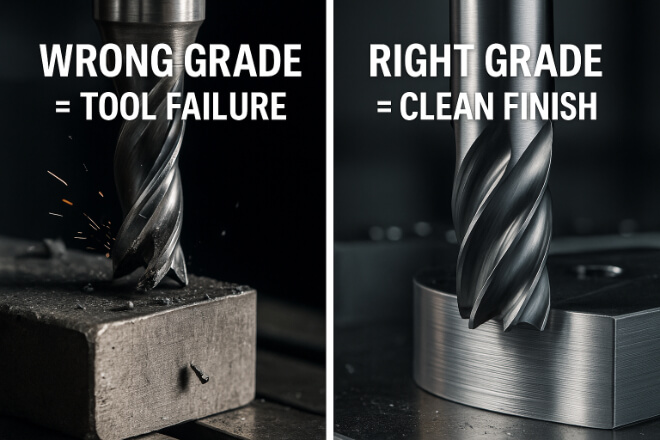
잘못된 등급을 사용하면 다음과 같은 결과가 발생할 수 있습니다.
공구 파손
조기 마모
표면 마감이 좋지 않음
낮은 생산성
더 높은 비용
반면에, 올바른 등급은 다음을 의미합니다.
더 긴 공구 수명
더 나은 표면 품질
더 빠른 가공 속도
향상된 치수 정확도
그렇기 때문에 모든 가공 작업에서 올바른 텅스텐 카바이드 등급을 선택하는 것이 중요합니다.
3. 성적 분류 방법
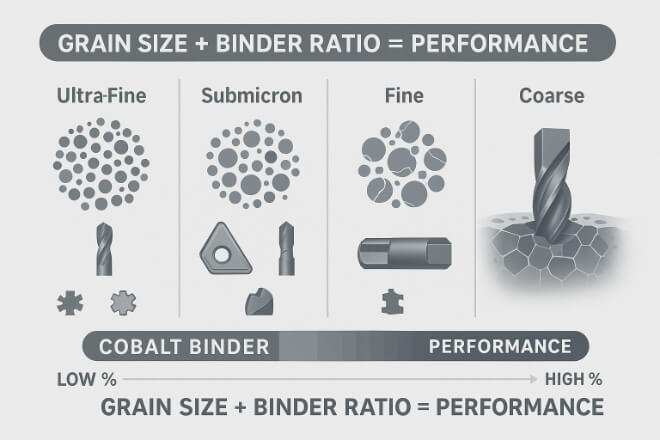
텅스텐 카바이드 등급은 보편적인 기준을 따르지 않지만, 대부분의 제조업체는 입자 크기, 결합제 비율, 그리고 적용 분야를 기반으로 하는 시스템을 사용합니다. 다음과 같이 분류됩니다.
1) 입자 크기(미세구조)
초미세(<0.5 µm): 날카로운 도구, 높은 내마모성, 그리고 마무리
미세(0.5–1.0 µm): 적당한 마모와 강도 균형에 적합
중간(1–2 µm): 일반 용도, 다양한 작업에 적합
거친(>2µm): 인성이 더 좋고 내마모성이 낮음
2). 바인더 함량(코발트 %):
6–10% Co: 더 높음 경도, 인성이 낮음(단단한 소재에 가장 적합)
10–20% Co: 더 높은 인성, 더 나은 충격 저항성
3) ISO 분류(인서트용):
P등급: 강철
M등급: 스테인리스 스틸
K등급: 주철
N등급: 비철(알루미늄, 구리)
S등급: 고온합금(인코넬, 티타늄)
H등급: 경화된 재료
4. 일반적인 텅스텐 카바이드 등급 및 용도
다음은 일반적인 카바이드 등급과 그 용도를 보여주는 간단한 참고 차트입니다.
| 학년 유형 | 입자 크기 | 코발트 % | 가장 적합한 |
|---|---|---|---|
| 초미세(UF) | < 0.5마이크로미터 | 6–10% | 마감, 날카로운 모서리, 알루미늄, 플라스틱 |
| 고운 입자(F) | 0.5–1마이크로미터 | 6–12% | 일반용, 경량강철, 구리 |
| 중간 곡물(M) | 1~2마이크로미터 | 10–15% | 강철, 주철, 다양한 용도 |
| 거친 곡물(C) | > 2마이크로미터 | 15–20% | 고강도, 단속 절단, 충격 저항성 |
5. 지원서에 맞는 등급 선택

가공하려는 재료에 따라 적절한 초경 등급을 선택하는 방법은 다음과 같습니다.
1). 알루미늄 및 비철 소재
광택 플루트가 있는 초미립 카바이드를 사용하세요
더 날카로운 모서리를 위한 낮은 코발트 함량
높은 RPM과 깨끗한 마무리에 이상적입니다.
2). 강철(연강, 합금강)
중간 정도의 결합제를 함유한 중간 입자 카바이드를 선택하십시오.
내열성을 위해 TiAlN 또는 AlCrN과 같은 코팅을 찾으세요.
3). 스테인리스 스틸
경도와 인성의 균형이 필요합니다
미세 입자, 10–15% 코발트를 사용하세요
날카로운 모서리를 피하고 둥근 프로필을 사용하세요.
4). 주철
더 단단한 등급, 중간 또는 미세한 입자를 사용하세요
날카로운 도구는 효과가 떨어집니다. 날카로움을 더한 도구를 선택하세요.
5). 티타늄 및 고온 합금
강력한 코팅이 있는 초미립 카바이드가 필요합니다.
DLC 또는 TiAlN 코팅으로 칩 용접을 피하십시오.
6). 경화강
낮은 코발트, 높은 경도의 카바이드가 필요합니다.
종종 세라믹 또는 PCD 팁과 함께 사용됨
6. 코팅도 중요합니다
가장 좋은 카바이드 등급이라도 좋은 성능을 발휘하려면 적절한 코팅이 필요합니다.
초경 공구에 사용되는 몇 가지 인기 있는 코팅 유형은 다음과 같습니다.
| 코팅 | 가장 적합한 | 주요 이점 |
|---|---|---|
| 주석 | 일반적인 사용 | 경도 증가 |
| 티알인 | 강철, 고온 합금 | 내열성, 긴 공구 수명 |
| 알틴 | 경화강 | 고온, 건식 절단에도 강함 |
| 다운로드 가능 콘텐츠 | 알루미늄, 플라스틱 | 붙는 현상 감소, 매끄러운 절단 |
팁: 적절한 등급과 코팅을 조합하는 것이 좋은 결과와 훌륭한 결과를 구분합니다.
7. 적절한 등급을 사용하면 비용을 절약할 수 있는 이유
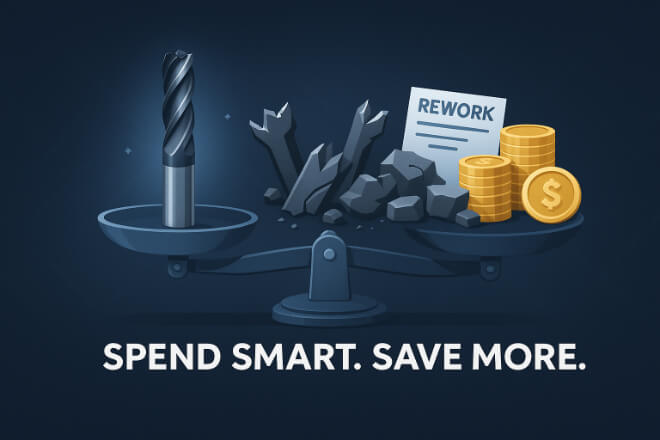
많은 상점에서 비용만을 기준으로 도구를 선택합니다. 하지만 잘못된 등급을 사용하면 다음과 같은 문제가 발생합니다.
더 빠른 도구 마모
잦은 교체
표면 품질이 좋지 않음
더 많은 다운타임과 재작업
반면에 적절한 카바이드 등급은 다음과 같은 데 도움이 됩니다.
더 빠른 속도로 실행
더 나은 마무리를 달성하세요
공구 파손 감소
부품당 비용 절감
CNC 효율성을 높이세요
따라서 프리미엄급 도구는 처음에는 비용이 더 많이 들지만 장기적으로는 더 많은 비용을 절감할 수 있습니다.
9. 최종 체크리스트: 선택하기 전에 무엇을 물어봐야 할까요?

다음 절삭 공구를 구매하기 전에 다음 사항을 물어보세요.
어떤 재료를 자르나요?
어떤 작업을 수행하고 있나요(거친 작업, 마무리 작업, 드릴링)?
공구는 어느 정도의 열과 마모를 겪게 됩니까?
(단속적인 절단 시) 충격 저항성이 필요합니까?
어떤 표면 마감을 기대해야 하나요?
마지막 생각
텅스텐 카바이드 공구는 강력하지만, 용도에 맞는 올바른 등급을 선택해야만 가능합니다.
입자 크기, 바인더 함량, 코팅을 이해하면 도구 수명을 늘리고, 마감을 매끄럽게 하고, 가공 속도를 높일 수 있습니다.
그냥 도구를 사는 게 아니라, 자신의 필요에 맞춰 도구를 골라보세요.
회사에 대한 자세한 내용을 알고 싶으시면 언제든지 문의해 주세요. 문의하기.

